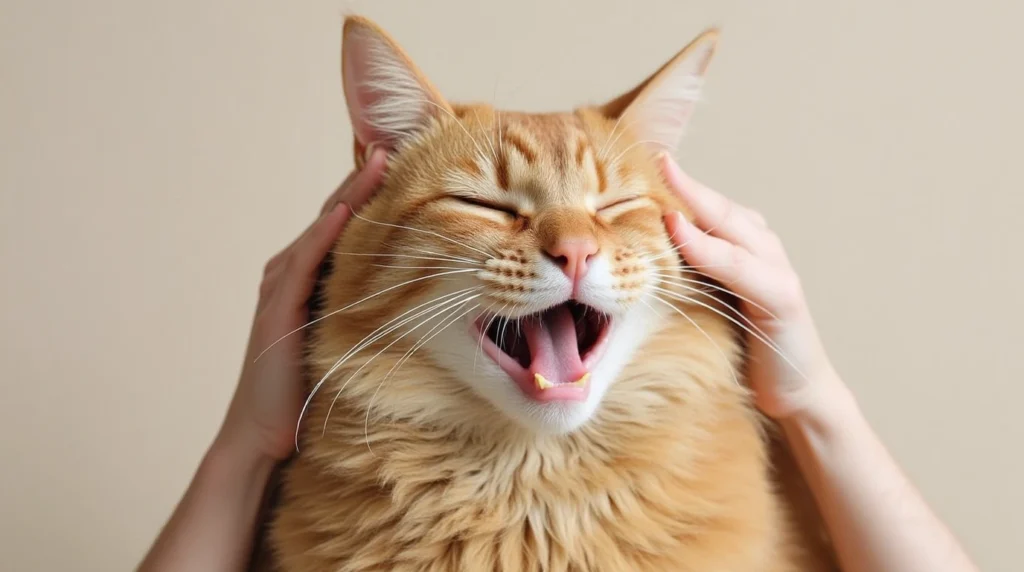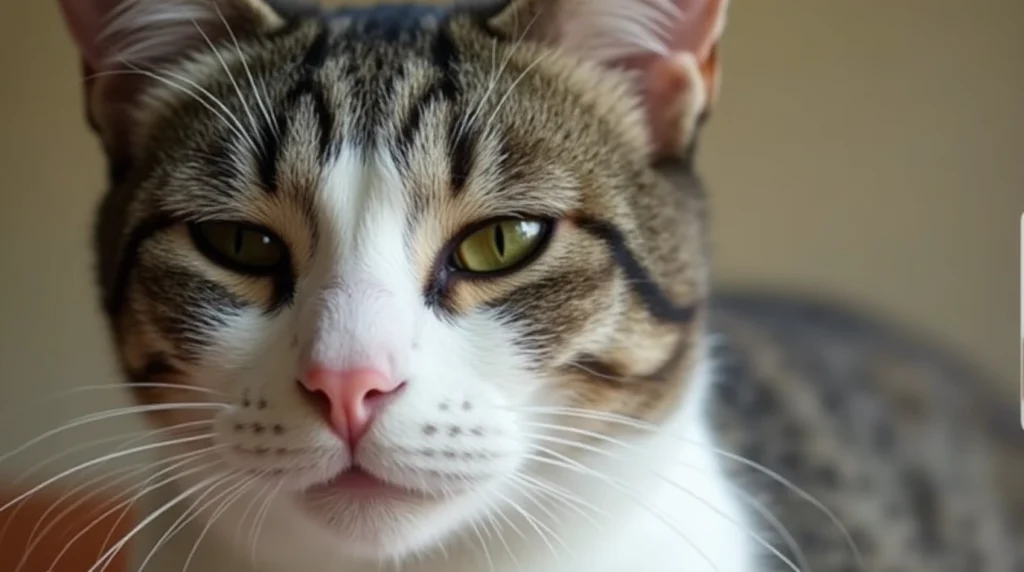Do Cats Get Headaches– Imagine this: your usually playful, curious cat is suddenly hiding under the bed, flinching at light, and refusing food. If they were human, you might suspect a pounding headache. But can cats actually get headaches?
Short answer: Probably — but it’s more complex than that.
Cats, like all mammals, have nervous systems capable of processing pain, and yes, this includes the kind of cranial discomfort we humans call headaches. While they can’t tell us “my head hurts,” there’s growing veterinary consensus that cats can suffer from conditions that cause head pain. The trick is learning to read their silent signals.
This article is here to demystify that question. We’ll explore what might cause a cat to experience head pain, how to recognize subtle symptoms, and — just as importantly — what you can do to help. Whether you’re a seasoned pet parent or new to feline behaviors, you’ll leave with clearer insight into one of the more invisible corners of your cat’s health.
And let’s be honest — if your cat’s even a bit off, you feel it. That sixth sense of “something’s not quite right” is often your best clue. But instead of jumping to conclusions or Googling “cat acting weird,” let’s walk through this together with a grounded, vet-backed understanding of what could be going on.
Table of Contents

Understanding Feline Headaches: What Science Suggests
While the term “headache” is rooted in human experience, the idea that cats can suffer similar pain isn’t far-fetched — just understudied. Pain in the cranial region, whether from illness or injury, is almost certainly part of the feline experience. But here’s where things get fuzzy: unlike us, cats can’t describe pressure behind their eyes or a throbbing temple.
Veterinarians tend to classify feline headaches under a broader umbrella of “cephalic pain,” which can be either primary (originating in the head with no identifiable cause) or secondary (linked to underlying conditions like sinus infections, dental disease, or high blood pressure). Sound familiar? It should — humans experience these same divisions.
How Do Headaches Work in Cats? Do Cats Get Headaches.
The anatomy is all there. Cats have pain receptors (nociceptors) in the same regions we do: the meninges (the brain’s outer lining), the eyes, the sinuses, even the scalp. When triggered — say, by inflammation, trauma, or illness — these receptors send pain signals to the brain.
But here’s the rub: cats evolved to hide pain. In the wild, weakness makes you a target. So even a cat suffering significant discomfort may act only slightly different — a little withdrawn, less playful, more reactive to touch. These aren’t just “bad mood” days. They could be your cat’s way of coping with a dull, persistent ache.
What the Research Says (and Doesn’t Say)
Direct studies on feline headaches are scarce. Most veterinary literature discusses cephalic pain in the context of larger diseases — tumors, trauma, toxoplasmosis. That doesn’t mean headaches are rare; it just means they’re underreported and often missed unless they coincide with more dramatic symptoms.
So how do we know they happen? Clinical extrapolation. The feline brain shares many structural and functional similarities with the human brain. The logic is this: if humans and dogs can get headaches (and dogs can, confirmed through veterinary neurology), there’s no reason to believe cats are exempt.
FAQ: Can cats get migraines like humans?
Technically, no — but maybe something similar.
While there’s no confirmed evidence that cats suffer human-style migraines (complete with aura and nausea), they can experience pain patterns that mimic them. Conditions like cluster seizures or trigeminal nerve inflammation may cause symptoms like light sensitivity, facial pain, or vocalizing — all of which might be feline versions of a migraine, though we can’t know for sure.
Causes of Headaches in Cats: What Triggers Feline Head Pain?

Let’s get real: headaches don’t come out of nowhere — not for us, and not for our feline companions. If your cat is experiencing head pain, there’s almost always a deeper reason behind it. While we can’t ask them directly, veterinary science gives us a decent roadmap of the usual suspects.
1. Medical Conditions That May Cause Head Pain
- High Blood Pressure (Hypertension): A surprisingly common issue in older cats, especially those with kidney disease or hyperthyroidism. Elevated pressure can damage delicate blood vessels in the brain and eyes — and yes, likely cause headaches.
- Sinus or Ear Infections: Just like in humans, blocked sinuses or ear canal inflammation can result in facial pressure and discomfort.
- Dental Problems: Abscessed teeth, inflamed gums, or oral infections often radiate pain upward, triggering discomfort in the head and jaw.
- Neurological Issues: Brain tumors, seizures, or trauma can directly irritate nerves and pain centers in the head.
- Eye Disorders: Glaucoma (which increases eye pressure) is not just a vision threat — it’s incredibly painful and can trigger chronic head pain.
2. Environmental & Lifestyle Factors
- Excessive Light or Noise: Some cats are highly sensitive to loud environments or bright lights, especially if they’re already in pain or recovering from illness.
- Toxins or Chemical Exposure: Ingesting or inhaling toxic substances (like household cleaners, essential oils, or certain plants) can trigger neurological symptoms — including head pain.
- Stress or Overstimulation: Chronic stress isn’t just an emotional issue. It can manifest physically, tightening muscles and possibly aggravating cranial nerves. Do Cats Get Headaches.
3. Less Obvious Triggers
- Vaccination or Medication Reactions: Rare, but possible — especially if your cat seems unwell after a vet visit.
- Allergies or Sensitivities: Inflammation from allergies may lead to pressure buildup in the sinuses.
- Dehydration: Not drinking enough can cause electrolyte imbalances that might affect brain function and pain signaling.
FAQ: Can stress alone cause a cat to get a headache?
Possibly.
While it’s tough to pinpoint, stress triggers a cascade of hormonal and physical changes — including tightened muscles, elevated blood pressure, and heightened sensory processing. In a highly sensitive cat, these responses could reasonably lead to discomfort that feels very similar to a headache. Do Cats Get Headaches
How to Tell if Your Cat Has a Headache: Signs and Symptoms
Cats don’t come with a pain meter — and they definitely won’t curl up next to you and say, “Hey, my head’s killing me.” But if you know what to look for, their bodies often whisper what their mouths can’t say. Recognizing a potential headache in your cat means tuning into behavior, not waiting for dramatic symptoms. Do Cats Get Headaches
Subtle Behavioral Clues
- Withdrawing or hiding: A cat in pain often seeks quiet, dark places to avoid stimulation.
- Irritability or aggression: Suddenly snappy when touched — especially around the head or face? That’s a red flag.
- Reduced appetite: Headaches can dull the senses, including smell and taste, making food less appealing.
- Pacing or restlessness: Pain doesn’t always look like stillness. Some cats can’t settle when they’re uncomfortable.
- Overreacting to touch: Flinching or pulling away from petting, especially near the ears, jaw, or top of the head.
Physical Signs to Watch
- Squinting or light sensitivity: If your cat prefers low-light areas or avoids windows, their eyes — and possibly head — may be hurting.
- Dilated pupils: While not specific to headaches, they can signal stress or pain.
- Facial tension: Tight jaw muscles, furrowed brow (yes, cats have them), or even subtle changes in ear position can all be indicators.
- Vocal changes: Excessive meowing, especially low or guttural sounds, can mean discomfort.
Context Matters
A single symptom doesn’t equal a headache — cats are weird sometimes, and quirks happen. But if you’re noticing a cluster of changes, especially ones that persist beyond a day or two, it’s time to take it seriously. Trust your gut: if your cat seems “off,” that intuition is often right. Do Cats Get Headaches.
FAQ: What should I do if I think my cat has a headache?
Start by observing, then act.
Track symptoms over 24–48 hours. If your cat is eating, drinking, and using the litter box normally — but acting odd — it may be okay to monitor. But if symptoms worsen, persist, or are accompanied by vomiting, lethargy, or wobbliness, call your vet immediately. They may run a physical exam, bloodwork, or neurological tests to rule out deeper issues. Do Cats Get Headaches
Diagnosing and Treating Headaches in Cats: What Vets Can (and Can’t) Do
Let’s not sugarcoat it — diagnosing a headache in a cat isn’t straightforward. Since your feline friend can’t describe the throbbing, pulsing, or pounding sensations we associate with head pain, veterinarians have to piece things together like detectives: using clues, ruling out suspects, and trusting their clinical instincts. Do Cats Get Headaches
How Vets Approach the Problem
The goal isn’t to prove a headache exists — it’s to identify what might be causing it.
- Physical Examination: Your vet will start by gently feeling your cat’s head, neck, jaw, and sinuses, watching for flinches or signs of discomfort.
- Neurological Evaluation: Reflex tests, eye tracking, and muscle tone checks help spot underlying neurological issues that could trigger head pain.
- Bloodwork and Urinalysis: These help uncover systemic issues — like kidney disease or hypertension — that are known to cause head-related symptoms.
- Imaging (X-rays, MRI, CT scans): Reserved for complex or ongoing cases, these tools can reveal tumors, structural problems, or hidden inflammation.Do Cats Get Headaches.
Sometimes, despite all this, no definitive cause is found. That doesn’t mean your cat’s not in pain — just that it’s harder to confirm. Do Cats Get Headaches
Treatment Options: What You Can Do
While treating the root cause is always the goal, symptom relief matters too. Here’s what might be on the table:
- Prescription Medication: If a specific condition like high blood pressure or an infection is found, treating it often resolves the head pain.
- Pain Management: Vets may use medications like gabapentin, buprenorphine, or anti-inflammatories — all dosed specifically for feline safety.
- Home Comfort Adjustments:
- Provide a dark, quiet space.
- Keep stimulation to a minimum.
- Monitor hydration and food intake.
Important: Never give human painkillers (like Tylenol or Advil) to your cat. These are toxic and can cause liver or kidney failure.Do Cats Get Headaches.
When the Cause Remains a Mystery
Sometimes, even after all the testing, no clear trigger is found. In these cases, your vet may suggest conservative management: observation, stress reduction, and routine follow-ups. That doesn’t mean giving up — it means working with the unknown, a frustrating but common part of feline medicine. Do Cats Get Headaches
FAQ: Can a vet really diagnose a “headache” in a cat?
Not directly — but they can get close.
Headache is a subjective experience, so vets can’t confirm it the way they would a broken bone. But by recognizing pain signs, ruling out other causes, and observing responses to treatment, they can often reasonably infer that a cat is experiencing head pain. Do Cats Get Headaches
Preventing Headaches in Cats: Everyday Strategies That Make a Difference
The idea of preventing headaches in your cat might feel a bit abstract. After all, how do you avoid something you can’t even confirm is happening? But here’s the thing: many of the root causes of feline head pain are avoidable or manageable with just a little foresight.
Prevention isn’t magic — it’s maintenance. And in this case, it’s about creating a lifestyle that keeps your cat’s body and mind in harmony. Do Cats Get Headaches
1. Control Underlying Medical Risks
- Monitor Blood Pressure: Especially for senior cats or those with kidney or thyroid issues. A quick check at the vet can prevent long-term damage (and potential cranial pain).
- Prioritize Dental Health: Annual dental exams and cleanings help prevent oral infections that can radiate into the jaw and skull.
- Vaccinations & Parasite Control: Routine care helps prevent infections that might lead to inflammation or neurological distress.
2. Build a Low-Stress Environment
Chronic stress is a known trigger for physical symptoms in cats. You can reduce their mental load by:
- Providing Hiding Spots: A cozy nook or cat cave offers retreat from overstimulation.
- Avoiding Sudden Changes: Move furniture, change routines, or introduce new pets slowly.
- Using Calming Aids: Products like pheromone diffusers (e.g., Feliway) may help create a sense of security.
3. Watch Their Diet and Hydration
- Consistent Nutrition: High-quality, vet-approved food supports overall health, including neurological function.
- Hydration Habits: Encourage water intake with fountains or wet food, especially in warmer months.
4. Regular Vet Checkups
Even if your cat seems fine, don’t skip those annual appointments. Subtle issues like hypertension or glaucoma often go unnoticed until they’re serious. Early detection is your best defense.
FAQ: Can changing my cat’s environment reduce their risk of headaches?
Yes, absolutely.
Cats are creatures of habit. Environmental stability — predictable routines, quiet spaces, minimal overstimulation — lowers stress and supports better health overall. Think of it like migraine prevention in humans: avoid the triggers, support the system.

Real-Life Cases: When Cats Show Signs of Headaches–Do Cats Get Headaches.
Science gives us the framework — but stories make it real. While clinical research on feline headaches is thin, veterinary case notes and owner experiences bring this issue into focus. The following real-world scenarios reveal what head pain might look like when it walks (or slinks) into the exam room.Do Cats Get Headaches.
Case 1: The Reluctant Groomer
Cat: Bella, a 9-year-old calico
Symptoms: Sudden aversion to head petting, pawing at ears, loss of interest in grooming
Diagnosis: Inner ear infection and mild dental disease
Outcome: After antibiotics and dental cleaning, Bella returned to her affectionate, well-groomed self. Her vet strongly suspected localized cranial pain.
What stood out here was the change in behavior. Bella’s discomfort wasn’t loud — it was subtle, persistent, and easily mistaken for aging or moodiness.
Case 2: The Light-Avoidant Senior
Cat: Jasper, 13, domestic longhair
Symptoms: Prefers dark spaces, squints in daylight, lethargic
Diagnosis: Advanced glaucoma causing elevated eye pressure
Outcome: After initiating pressure-reducing eye drops, Jasper’s behavior improved markedly. His vet noted that untreated, his condition could lead to chronic pain — including head discomfort.
This one hits close to home for many older cat parents. Gradual shifts, like seeking darkness or blinking excessively, are easy to miss until they add up.
Case 3: The Stress Sponge
Cat: Nala, 4, Siamese
Symptoms: Hiding, pacing, head-tilting after a move to a new apartment
Diagnosis: No medical issue found, but suspected stress-induced muscle tension
Outcome: After a few weeks in a quiet, stable environment and a calming diffuser, Nala returned to her playful self.
Though no physical cause was confirmed, her vet noted the likelihood of stress-triggered discomfort — something that could resemble a tension headache in humans.
FAQ: Why don’t we hear more real-life stories about cats and headaches?
Because most go unrecognized.
Unless a symptom escalates into something dramatic — seizures, vomiting, dramatic lethargy — it rarely gets flagged as a potential headache. That doesn’t mean it isn’t there; it just means we’re still learning how to listen better.
So, do cats get headaches?
While the verdict isn’t black-and-white, the evidence suggests a strong “probably.” The anatomy is there. The triggers are familiar. And the behaviors — subtle as they may be — point to a form of discomfort we might reasonably call a headache.
But this isn’t just about labels. It’s about sharpening our sensitivity to what our cats are silently telling us. They don’t cry out. They don’t sulk dramatically. They change — slightly, slowly, and often in ways that are easy to chalk up to mood or age.
Being a cat parent means becoming a low-key detective. It means noticing that they blink longer in the sunlight. That they no longer leap onto the window sill. That they flinch — just slightly — when you scratch behind the ear.
These aren’t overreactions. They’re instincts honed by love.
So if your cat seems “off,” listen. Watch. Trust the tug in your gut. And when in doubt, call the vet. Because even if we can’t confirm every ache and pain, we can still show up for them — attentively, gently, and in ways they understand.
And sometimes, that’s all they need.
Do Cats Get Headaches Do Cats Get Headaches Do Cats Get Headaches Do Cats Get Headaches Do Cats Get Headaches Do Cats Get Headaches Do Cats Get Headaches Do Cats Get Headaches Do Cats Get Headaches Do Cats Get Headaches

